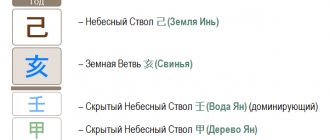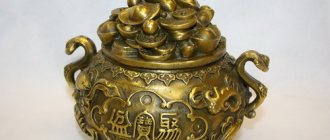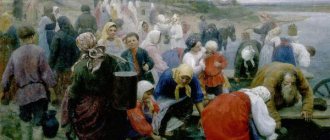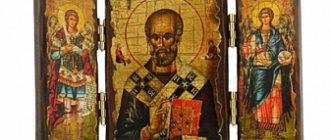An icon is an image of God, and all believers try to keep the holy face safe and sound, since it is a kind of amulet against evil forces. But metal and copper heirlooms deteriorate over the years, becoming corroded or oxidized. In addition, there are ancient icons that are passed down from generation to generation, and in order for the family value to go to children, it is necessary to know how to wash icons and treat them with care.
It would seem that keeping sacred relics at home is very simple and nothing will happen to them, but this is not so. A hot or humid indoor climate can damage icons. Following gradual corrosion, the image of God or other saints will deteriorate, and the family value will fall into disrepair. Therefore, it is important not only to pray before the face, but also to properly care for it.
Minor damage to the relic can be repaired with your own hands at home. But the peeling paint and deformation of the plywood are difficult to correct, so special restoration will be required in the church.
Repairing an icon is not an easy task, but it is doable. To minimize the risk of new damage, home restoration should be carried out with the utmost care.
How to clean copper icons, as well as silver, gold and bronze:
Colorful coating
Images should be washed only with soft cloths: napkins and rags without coarse lint. Church experts advise washing icons in the following ways:
Important! The water used to wash the icons is not poured into the sink or onto the paths. It should only be poured into the garden - in a place where people do not go. If you do otherwise, then, as the clergy say, it is a sin.
If cleaning icons on your own at home scares the owner, then it is better for him to resort to professional services. Incorrect procedures can further damage the coating.
Features of processing an image affected by microbes
Most often, the damage is concentrated on the surface. Restoration of the icon in such a case consists of disinfection and conservation. That is, in surface treatment with the subsequent introduction of toxic substances inside in order to destroy microorganisms.
It should be remembered that it is very important to follow safety precautions when working. Be sure to cover any cuts or wounds on exposed skin with a bandage, and don’t forget to put on a gown and wash your hands after finishing the procedure.
Mold and mildew removal
The sacred image on the tree can be destroyed due to mold, which spreads very quickly. If mold has formed on the front of the icon, in order to avoid damage to the face, you should take the icon to a restorer. Removing mold in a visible place yourself is very difficult and can do more harm than good.
If the fungus has spread to the back of the heirloom, you can remove it yourself. You will need a brush whose bristles are made of nylon.
How to remove mold from wooden surfaces of icons:
Under no circumstances should you wash icons with water, otherwise it will seep into more difficult places, and therefore, within a short period of time, the face and paint coating will be damaged.
Working solutions
Do-it-yourself restoration of icons is carried out through the use of special emulsions. Each of them has its own purpose:
- fish glue is used for fixing the paint layer, restoring wooden parts of icons and for preventive gluing;
- beeswax dissolved in gasoline helps to process the ends of the wooden part of the structure;
- Wax mastics of different contents are used for peeling paint and for soil sagging. With their help, the wooden part is restored and cracks are sealed;
- an alcohol solution is used to strengthen images that have been lying in a damp room for a long time;
- DDT solution helps when the icon is affected by insects;
- an emulsion based on water and yolk strengthens the paint when peeling in the form of blisters;
- an aqueous surfactant solution is used to clean dirt on the surface of the icon.
Storage rules
Proper care will ensure long-term storage of family value. Therefore, in order to avoid having to restore the paintwork and wipe off soot from the icon, it is recommended to store relics only in the appropriate places and follow simple rules. Recommendations from experts on caring for icons:
By following simple rules, the icon can be preserved not only by children, but also by grandchildren and great-grandchildren. If small cracks have formed in the image, you should urgently go to a church restorer or other experienced specialist. To get detailed advice, you should visit a church and get advice from experienced people. One of the duties of true believers is not only keeping the commandments, but also carefully storing icons and other sacred church utensils.
An icon is one of the greatest works of art, being a sacredly preserved family heirloom.
A believer must have images of saints in his home. They guard the house and protect its inhabitants.
For most people, an icon is a family treasure that is carefully preserved and then passed on to children. Many images may turn out to be very old; they require the right attitude, both emotionally and materially.
What problems may arise during storage?
Storing icons at home is not an easy task. Exposure to atmospheric conditions negatively affects them. Frequent temperature changes, high humidity, drafts and too warm air can lead to damage to the image.
It is important to be able to handle such art correctly, and not just pray and ask for help.
Image owners often encounter the following problems:
- soot from candles;
- dust;
- paint shedding;
- peeling;
- deformation of the board due to the icon being in a warm place;
- fungus and mold due to high humidity.
You can also clean icons at home if the damage is not severe.
If the board is deformed or paint is falling off, restoration is required. In this case, contact a specialist.
Metal
Restoring icons at home is a difficult task. It is important to be careful not to cause further damage.
How to wash icons:
- Cleaning images based on copper chasing with tooth powder. Icons are difficult to clean if they are made of gold, silver and copper, and also have a carved texture. Clean the images using special products designed for jewelry or other metals. At home, copper icons are cared for using tooth powder. As an alternative, you can use Goya paste. Copper frames are also cleaned using a paste (purchased at a specialty store) designed for this metal.
- Vodka and diluted alcohol for gold and silver. After using these products, the cleaned icon will shine with purity. Vodka is applied using a cotton swab or stick. First, the product is applied to an inconspicuous area; if the protective layer of varnish does not come off, you can wash the entire surface.
- Cleaning combined icons with cranberries and barrel tomatoes. In this case, the image consists of metal and boards. It is important to carry out the restoration procedure carefully so as not to damage the drawing. Copper is rubbed with cranberries; you can use sour barrel tomatoes. These products are rubbed onto the metal and left to dry. Then wipe with a dry cloth. You can repeat the procedure until the copper clears.
- Ammonia. You can also clean the icon frame with ammonia. It must be carefully applied with a natural brush, wait a while, and then rinse and dry.
- Citric acid or acetic acid is suitable for gold products. For copper and bronze, the solution should not be too concentrated; immediately after using the product, the product must be rinsed with clean water.
Restorers do not recommend using dishwashing detergents. Also, do not use aggressive cleaning agents that may scratch the frame.
paint layer
Any events with the faces of saints must be carried out slowly and carefully. Wash icons with soft cloths and wet wipes.
At home, you can restore the paint layer in the following ways:
- Usage . Soap solution removes soot well. But frequent use can lead to the face being partially or completely erased. As a result, the most valuable icons are lost.
- The yolk of a chicken egg, boiled chilled water, turpentine, and alcohol in a ratio of 1:5:2:2 will help get rid of soot. Mix the composition well and apply with a soft brush or cotton swab. Then wipe the paint layer with a dry cloth.
- How to properly restore an icon yourself if the paint layer begins to peel off? To do this, use 1 chicken egg yolk and 5 parts water. The emulsion is applied to the damaged areas and dried for 1 hour. This manipulation is repeated several times. Then you need to moisten the damaged areas with the same solution and press them against the board.
- Vegetable oil will help return the color to the icon. In the old days they used olive oil. They wipe the face with it once a month. Apply a thin layer.
If a woman previously cleaned an icon, but it began to lose color and fade, you should contact a restorer.
After the icon has been cleaned, do not pour water into the sink. It can only be poured into an unlikely place on the street.
Cleaning and restoration is a delicate process and requires care. If you have doubts about this, it is better to use the services of a specialist.
Fungus and mold
It grows quickly and destroys the board on which the face is depicted. If it begins to appear on the front side, it is better to contact a restorer so as not to spoil the paint layer when cleaning.
Mold on the underside of the board can be removed at home. To remove it you will need a sponge and a brush with nylon bristles.
Methods for removing mold from a wooden surface:
- Hydrogen peroxide is applied to a cotton pad and wiped over the affected surface. If it starts to go away, you can treat the moldy area again.
- A small colony of mold can be destroyed by baking soda and vinegar. This is an emergency measure that cannot be used permanently. You can resort to this method if it is not possible to give the icon to a restorer, but no more than 1 time. Dilute baking soda in vinegar and wipe the infected area with a cotton swab.
- You can only use soda. It is slightly moistened and rubbed into the damaged area. Then it is wiped off with a dry cloth.
The main rule is not to wash with water. The liquid can penetrate deeper layers, reach the paint surface and ruin the face.
Work progress
Next, place the leaf on the surface, straighten it with a roller without pressing. Puncture it with a surgical probe so that the adhesive is fully pressed.
We suggest you read: How to properly arrange dishes in the dishwasher?
It must be removed in the future either by steaming or using a damp swab. If it was applied correctly initially, it will come off without problems. If not, you need to use a special spatula, but you should be careful not to spoil the icon. It is strictly forbidden to allow glue to remain on its surface.
Storage and placement
To prevent the icon from having to be cleaned of soot, mold and damaged paintwork, it is necessary to properly care for it. It is possible to create suitable conditions for an icon, the main thing is to have the desire and approach the matter correctly.
- Candles should be lit at a distance of 15 cm from the face.
- It is necessary to broadcast away from windows, vents and radiators. It is better to install on special shelves so that there is air movement.
- It cannot be kept in direct sunlight, which is why most churches have stained glass windows.
- The room should not be too humid. This creates excellent conditions for mold growth.
- Do not cover the front side with alcohol varnishes.
- Do not use fat-based products or alkaline products.
- It is also not recommended to wipe with plain water. Such care for the icon will lead to its partial or complete destruction. Whitish spots may appear on the paint layer.
- You can only brush off the dust with a soft cloth or brush.
- It is important to monitor the temperature. A constant temperature change will damage the paint and protective layer; the icon may swell, crack and lose its original appearance.
- You should not scrape off the “bogs” (bulging spots left by flies). This can damage the paint layer. You should immediately contact a restorer, since the “seeds” react with the paint and can burn it down to the gesso.
It is important to remember that if the face begins to crack or deform due to moisture, you cannot do without the help of a restorer.
Before cleaning family treasures at home, first get the advice of an experienced professional.
The duty of believers and non-believers is to competently and carefully preserve icons.
How to properly clean icons - advice
Is it possible to clean icons at home?
First of all, you need to know that icons are not just products made of copper, brass, bronze or wood, like those products that are called jewelry or souvenirs. You can clean jewelry, or, for example, coins without any problems - easily and simply at home. But cleaning an icon is essentially restoration. Restoration, the essence of which is not just to clean, making the icon sparkling and shining, but to recreate its original appearance, without changing the icon, without damaging it, without scratching it.
Therefore, if the icon is made of copper or bronze, or it is silver-plated, gilded, then cleaning such an icon at home is always a big risk of spoiling it and damaging it. Therefore, the best option is to turn to specialist restorers.
Well, if you still try to clean the icon yourself at home, then, according to the advice of the experts themselves, the most suitable remedy is to use vodka or alcohol diluted with water.
A cotton swab must be moistened with vodka or alcohol, and carefully try to wipe the outermost places or corners of the icon, and not the very center of the depicted faces. Take a break and see how everything is going, if everything is fine. If the varnish or paint layer does not wash off or remain on the swab, then only continue wiping the entire icon using this method. Otherwise, if the varnish or paint layer is erased, the icon will be left without a protective layer, and over time it will darken in those places and become covered with oxide with elements of corrosion.
There are, of course, ways to clean icons at home that are used by people. This is the use of ammonia. This is, of course, if the icon is made of copper or brass, bronze or silver, gold. An embossed icon, for example, like this -
Copper icon after cleaning with ammonia. The right side - light - has been cleaned. How to properly clean icons - advice
Pour ammonia into a bath or container of appropriate size, the level of which just covers the surface of the icon, hold for several minutes (10 - 15 minutes), soak, all the oxide begins to come off from the icon, then remove and rinse with warm water, and dry icon with soft napkins or tampons.
They also use a similar “soaking” method with tomato juice (tomato) or brine, with lemon juice, instead of ammonia. You can make a soda paste with lemon juice - soda and juice - by rubbing the icon with this solution with a soft brush, or wipe it with the same cotton swab (you can use cotton swabs), then rinse with water and dry with napkins.
In ancient times, cranberry juice was used as a cleanser. They looked after the icons, took care of them, and wiped the icons with vegetable oil (olive), thereby maintaining the cleanliness of the icons and ridding them of oxide.
Let us note once again that the most suitable means for cleaning icons at home is vodka, or alcohol diluted half with water.
You should also remember that after cleaning the icon, all the water is not poured into the sink, but rather the water is poured into an unusual place on the street.
Old icons are passed down from generation to generation as family heirlooms. Indeed, these religious attributes are endowed with incredible miraculous powers, which is where their high value lies. But unfortunately, the power of the icon does not protect it from aging - fading of colors, deformation and other defects. Therefore, every person who has received such a valuable thing as an icon should know how to restore an icon at home, as well as clean it.
Ancient icon
Features of preventive sealing
The restoration of ancient icons also includes a stage that is a temporary solution for the conservation of certain deformations in order to prevent their subsequent development.
So, the sealing is applied for a period of one month to 3 years, it all depends on the degree of damage to the product and the conditions of its storage. The period cannot be exceeded, otherwise the icon may suffer additional damage. If there is a need to extend it, the adhesive must be changed.
We suggest you familiarize yourself with Cotton pre-wash
This process is carried out using special working solutions of alcohol and tissue paper. Any other types of it can cause severe shrinkage and tear off the already weak soil. The work is carried out with a wide bristle brush, a roller and a damp swab.
If there is mold on the surface, the sealer should be applied only after alcohol treatment. The paper should be cut into small sheets, the size of which depends on the degree of destruction of the icon and its type. Glue is applied to the surface with a brush so that it is all covered evenly, and a lot of glue is not needed. The main thing is that after drying, a film does not appear, which can cause peeling of the paint.
Storage
In order to prevent the influence of destructive factors on the icon, care should be taken to ensure its proper storage. An icon can deteriorate from dampness, cold and heat, so these factors should not be allowed to affect the stored relic. Grinder beetles, fumes from acids and solvents, soot and smoke can also damage ancient icons.
The ideal air temperature for storing icons is 15-18 degrees Celsius. In this case, humidity should not exceed 65%. To create ideal conditions for storing icons, it is recommended to buy an icon case - a special glazed box. It is especially necessary for storing handwritten icons. The icon case should not be perfectly sealed, because the icon located in it must “breathe”.
Many owners of icons, in order to give the relic shine and ideal appearance, cover its surface with vegetable and mineral oils. This should not be done, because over time, oil that gets into microcracks in the paint layer can lead to a distortion of the color scheme of the icon. If you want to return the icon to its original shine, it is recommended to use linseed oil (to cover the image) and a wax-turpentine mixture (to treat the back and sides).
Stages of icon restoration
How to remove surface contaminants
Restoring home icons rarely involves professional and painstaking work, because not everyone can prepare a special cleaning solution and perform high-quality sealing when necessary.
But even a person without special skills can remove dirt from the surface of the image. After all, icons, unfortunately, collect dust and other dirt over time.










